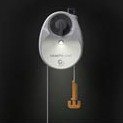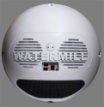Simple Inventions
 Over 2 billion people on earth don't have
electricity but these simple inventions are helping.
Over 2 billion people on earth don't have
electricity but these simple inventions are helping. Most live in rural or remote areas that are off the electrical grid but others can't afford electricity because they're poor and live on less than $2 a day.
Inventors have been working on this problem and have created effective, inexpensive, simple inventions that don't require electricity.
Jane Chen and Rajan Patel are co-inventors of the award winning incubator pouch for premature babies.
Jessica Lin, along with co-inventors, Hemali Thakker, Julia Silverman and Jessica Matthews invented the sOccket, an award winning innovation that uses a soccer ball to harness and store electrical energy when kicked.
Multiple award winning inventor Emily Cummins created an inexpensive, simple, organic refrigerator that refrigerates perishable foods and medicine.
 Inventors Jim Reeves and Martin
Riddiford wanted to create a simple invention that would make electricity.
Inventors Jim Reeves and Martin
Riddiford wanted to create a simple invention that would make electricity.
They spent four years developing their award winning GravityLight™, which is a light that requires no electricity, no batteries or solar dependency to operate. Instead it uses the force of gravity to create light.
A weight is connected to the end of a rope that loops through the light casing. The light is hung from any structure or tree. You pull on the rope to lift the weight to the casing.
When you let go of the rope the weight gradually falls and pulls the rope through gears that turn a small generator to power LEDS on the light.
The light shines for about 25 minutes and it only takes 3 seconds to pull the rope to restart the cycle again.
To demonstrate the feasibility of their invention they decided to raise funds for field testing. They launched a crowdfunding campaign on Indiegogo to raise $55,000 but received close to $400,000.
 Jim acknowledges that the success and support for the campaign was helped by an unexpected endorsement from Bill Gates who tweeted, "GravityLight is a pretty cool innovation which could be a source of cheap light in developing markets."
Jim acknowledges that the success and support for the campaign was helped by an unexpected endorsement from Bill Gates who tweeted, "GravityLight is a pretty cool innovation which could be a source of cheap light in developing markets."
Jim Reeves gives a great explanation of the development process he and Martin used to create GravityLight at a TEDx event, which you can watch here on Youtube.
Source: deciwatt.org; ted.com/tedx/events; creativecommons.org
Air Into Water
 Johathan Ritchey has invented the Watermill, which is an atmospheric water generator. It converts air into fresh water.
Johathan Ritchey has invented the Watermill, which is an atmospheric water generator. It converts air into fresh water.
This simple invention produces fresh water at a cost of about 3 cents a liter (1 quart). Originally designed for areas that do not have clean drinking water, the Watermill is for households that prefer an eco-friendly, cost effective alternative to bottled water.
Atmospheric water generators convert air into water when the temperature of the air becomes saturated with enough water vapor that it begins to condense (dew point).
"What is unique about the Watermill is that it has intelligence," says Ritche. This makes the appliance more efficient. It samples the air every 3 minutes to determine the most efficient time to convert the air into water.
It will also tell you when to change the carbon filter and will shut itself off if it cannot make pure clean water.
Sources: elementfour.com
No Battery Remote
 The battery-less remote control is a simple invention that uses energy-saving technology.
The battery-less remote control is a simple invention that uses energy-saving technology.
The remote control uses an electromagnetic induction coil and rotation gears to generate current.
The signal is transmitted a distance of several meters using infrared light. The current is activated by squeezing a trigger which in turn makes the remote functional.
Source: smk.co.jp
Batteries That Operate With Any Liquid
 Chungpin Liao, a professor at the Graduate School of Electro-Optic and Material Science of National Formosa University in Taiwan has invented an organic battery that creates electricity when wet.
Chungpin Liao, a professor at the Graduate School of Electro-Optic and Material Science of National Formosa University in Taiwan has invented an organic battery that creates electricity when wet.
The "organic" battery generates a charge within 10 seconds and will last anywhere from two days to a week depending on the liquid. It works with water, beverages or even urine.
Although it will only produce half the strength of traditional batteries, the organic battery has a storage capacity greater than water-powered fuel cells and is very cheap to manufacture.
Plus it contains no toxic substances and does not pose an environmental hazard" says Chungpin.
Liao received his degree in nuclear engineering from National Tsing Hua University in Hsinchu, Taiwan. He earned his Masters and Ph.D degrees in plasma science and fusion technology from the Massachusetts Institute of Technology in Cambridge, United States.
Source: www.nfu.edu.tw/eng/




